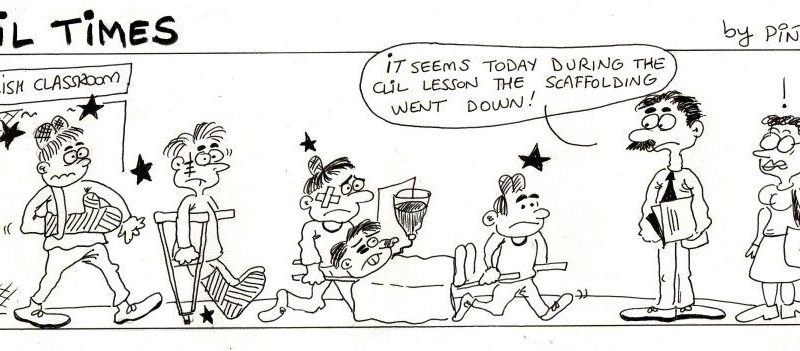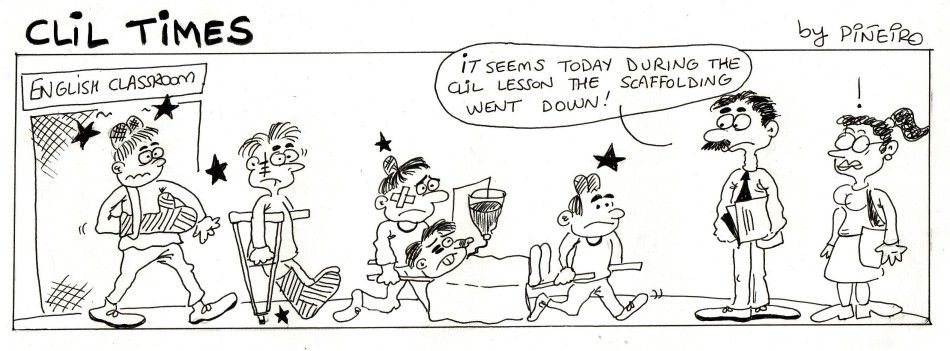CLIL, FROM THEORY TO PRACTICAL IMPLEMENTATION.
According to Marsh, Mehisto and Frigols (2008), these new generations born under the immediacy of “learn as you use, use as you learn” will be better catered for through an innovative methodology which integrates content and language. Although there are several approaches related to linking content and FL, we shall focus on CLIL as it represents the most widely accepted one.
Marsh defines CLIL is a dual-focused educational approach in which an additional language is used for learning and teaching of both content and language. Broadly speaking, content and language integrated language (CLIL) is an umbrella term which embraces different approaches in which some school subjects are covered through a foreign language, being the goals and outcomes related to both content and the foreign language.
Coyle, Hood and Marsh (2010) define CLIL as a dual-focussed educational approach in which an additional language is used for the learning and teaching of both content and language.
Dalton-Puffer (2007) suggests that the term CLIL refers to educational settings where a language other than the students´ mother tongue is used as a medium of instruction. In her view, although this approach is not exactly new, using a second language to teach content from other areas is certainly an innovation. In the European context, there are obvious socio-political reasons fostering the use of a second language as a medium of instruction, since the social demands of modern societies put pressure “on educational systems to provide skills which will allow students to stand their grounds in international contexts” (Dalton-Puffer, 2007).
The cornerstone of learning a second language through content from other areas (i.e. science, geography, art, etc) is connected to the idea that these areas provide a valuable framework for real and purposeful communication, in which the FL is used naturally. In this light, CLIL classrooms ensure authentic use of the language, and hence contribute to the development of the learners´ communicative competence. In this same line, Coyle, Hood and Marsh (2010) note that authenticity and relevance are key elements for successful learning. Similarly, they suggest that “successful language learning can be achieved when people have the opportunity to receive instruction, and at the same time experience real-life situations in which they can acquire the language more naturalistically”. Learning, for example, a topic related to science (i.e. animals´ life cycles) through a second language can develop a sense of authenticity, as long as it is done in a supported way.
There are several approaches focused on the integration of content and language and there is not just one view on how to apply CLIL since it can be implemented “at different levels”. However, there are some common methodological principles to all of them which are not just specific of this approach; rather they are embedded in positive educational practice. Some of these principles adapted from Marsh (2008) are the following:
Positive learning environment: Creating the optimal conditions for learning goes through plenty of classroom actions. Amongst others, we can mention:
- Fostering the students´ confidence through routines and achievable activities within their developmental stage. According to Vygotsky, activities should keep an adequate balance between linguistic demands and cognitive challenge. The zone of proximal development represents a valuable framework to design students´ tasks. This concept devised by Lev Vygotsky is defined as “the distance between what children can do by themselves and the next learning that they can be helped to achieve with competent assistance” (Raymond, 2000). The practical implication of this concept for teachers is obvious and extremely important, since it provides a valuable framework for the creation of a reasonable level of challenge in the students´ activities. In other words, there is no point in teaching below the bottom or above the top of the ZPD, because if activities are too easy children are likely to get bored and probably disruptive. On the other hand, if the tasks are too demanding and out of reach for our students, they will also feel discouraged, frustrated or anxious and in turn, disruptive
- Moreover, their confidence must be enhanced creating a free-anxious atmosphere, providing them with the opportunities to experiment with the FL and content, understanding that error is an unavoidable element of learning.
- Displaying language and content along the classroom and facilitating access to authentic learning materials and environments.
- Increasing the students´ language awareness through routine activities, self evaluation and the like.
Active learning: This methodological principle should be common for any approach within the scope of communicative language learning. In CLIL it is highlighted in several ways:
- Promoting students´ communication and helping to decide on the content, language and learning skills objectives, being the teacher in charge of selecting these elements according to their interests and preferences.
- Favouring co-operative work and getting them to evaluate their progress.
- Teachers assuming the role of facilitators of learning.
Scaffolding: This term refers to providing individualized support according to the learners´ ZPD (Zone of proximal development) to facilitate their ability to build on existing knowledge and thus internalize new information. In CLIL scaffolding is promoted by:
- Getting the students to build on prior knowledge, attitudes, skills and experiences.
- Catering for the different learning styles present in the classroom.
- Fostering their creativity, developing creative and critical thinking skills.
Authentic learning: One of the cornerstones of CLIL is using the foreign language with a purpose, so that students perceive the FLL as a motivating activity. In this sense, authenticity is promoted through different steps:
- Presenting language and content in meaningful contexts and connecting learning to their lives.
- Using authentic materials from the media.
Multiple focuses: This concept deals with practical aspects of CLIL implying:
- Supporting language learning through content integrating several subjects.
- Organizing and designing FL learning programming through cross-curricular topics and projects.
- Promoting reflection on the learning process and co-operation amongst the teachers embarked on this approach, including those who are not FL teachers.
- Fostering parental involvement so as to create realistic expectations and guide them on how to support children at home.
Given this, it seems clear that the integration of content favours the students´ natural acquisition of the language since knowledge is not presented in “fragmented realities” but rather in a holistic way. Therefore, even if this approach is used in a weak version or occasionally, there are a significant number of benefits in integrating FL learning and content.
- CLIL implies a viewpoint on learning that considers the children´s whole development.
- Integrating language and content is likely to result motivating for students since they usually enjoy experimenting, investigating and learning about the world they live in through English. Seen in this light, CLIL lessons can easily be seen as far more interesting, varied and enjoyable.
- Using the FL with a purpose does not only make the FL class more motivating; moreover, the focus on real and meaningful use of the FL contributes to a great extent to memorable learning.
- The variety of topics, resources, materials and activities inherent to CLIL methodology provide a context in which students use a combination of intelligences and learning styles. As a consequence, students have the chance to build on and take advantage of their strengths and overcome their weaknesses.
- Similarly, this approach encourages co-operative strategies on the part of both students and teachers. In this sense, the implementation of CLIL means a clear contribution to the basic competences, not only in linguistic terms, but also in learning to learn and autonomy and personal initiative
- Finally, it is worth considering that linking FL and content related to students´ interests tends to increase the levels of concentration and positive attitudes towards learning a foreign language amongst students.
In more practical terms, including a cross-curricular approach such as CLIL in the teacher´s programming requires defining its components and designing a framework which enables putting it in motion. Once this framework is clear, further decisions must be taken on the part of the teacher regarding the type of language, content, abilities and skills to be developed, as well as how to evaluate the outcomes in terms of content and language.
Coyle (2005) devised a useful conceptual framework of four descriptors under the heading of the 4 Cs, to support the inclusion of CLIL within the curriculum.
Cognition:
The first C in Coyle´s framework is related to engaging learners in high-order thinking and understanding, accepting challenges and reflecting on them. At this stage, the teacher must select the thinking skills, problem solving and creativity, ensuring that the cognitive demands match the learners´ developmental stage.
In order to organize cognition, the FL teacher should be aware of the following points (adapted from Marsh, Mehisto and Frigols, 2008):
- The content (from the different subject areas), the language and the learning skills should be designed according to the learners´ interests. Therefore, before devising a CLIL unit, we may gather information about students’ preferences. With young learners this can be done through a simple “likes and dislikes” chart, whereas with older students in the third cycle we can use overt strategies like written interviews, etc.
- The learning must be planned considering our students´ existing knowledge, skills and attitudes; therefore, a diagnostic evaluation is advisable to know the starting point.
- Before setting new outcomes, the teacher and students shall analyze the achieved outcomes.
- The knowledge and skills acquired should be applied to several subjects.
Content:
Content may simply be defined as the progression in new knowledge, skills and understanding. For the teacher´s practical application, it is always useful to think of content in terms of “what we want our students to learn, understand and do”, rather than just merely knowledge acquisition. The second “C” requires students to apply new content and develop related skills through experiential activities; so that the learners create their own knowledge and understanding.
Organizing content implies that the teacher must consider several principles:
- Content must be planned for a specific group of learners.
- Learners shall apply new content and develop related skills through experiential activities.
- Content is not limited to only one subject; rather, we must strive for the integration in all subjects.
Communication:
At this stage, the teacher must select the language to be learned and relate it to the learning context. As we know, communication implies that students must use the FL in the communicative contexts in which the language is presented. However, it is useful to distinguish between language learning, oftentimes understood as grammatical progression, and language using which focuses on communication and learning demands. However, we shall consider some central ideas to communication:
- Activities should entail active communicative participation on the part of the students.
- Classroom organization (i.e. desks arrangement, displays, etc) should support communication.
- Language skills and communication must be developed from all the areas.
Culture:
The last aspect in Coyle´s framework is related to develop “self” and “other” awareness and pluricultural understanding and as a way to extend content. In a practical classroom project, culture may include distinguishing different habitats from other countries, human impact on wild life and shared learning experiences through European programmes like eTwinning or Erasmus+.
The way to integrate content and foreign language in the curriculum will depend on different operating factors such as the time assigned to the FL, teacher availability or the extent to which coordination is assumed in a school.
A useful starting point to relate content and foreign language, whether following a CLIL approach or a similar one, is to make a “topic web”, a mind map or a simple chart.
| PLANNING CHART FOR A PROJECT ON BUGS for the second cycle. Adapted from Coyle. | ||||
| Cognition. | Insects´ characteristics.
Explain different bugs´ habitats. Understand relation between bugs food and habitats. |
|||
| Content. | Types of bugs (butterfly, beetle, ladybird…).
Bugs interaction and types of habitats. Bugs project: group work to compile information about a favourite bug on the internet, select images, write simple descriptive texts and report back to the class using the interactive white board. |
|||
| Communication. | Language
of learning.
|
Bugs vocabulary (Bee, beetle, ladybird, dragonfly…)
Body parts (head, legs, wings…) Action verbs (run, fly, jump, walk…) Colours and shapes (red, green, stripes, spots…) Description structures (it´s…, it has…) Expressing preferences (I like…, my favourite is…) |
||
| Language
for learning. |
Making questions (where do they live, what do they eat?…)
Cooperative language (can you help me? what does this mean? How many legs has a bee got?) |
|||
| Language
through learning. |
Prospective lexis: numbers, shapes…
Strategies: using the dictionary, searching in pre-selected web sites, co-operative group work, asking the teacher… |
|||
| Culture. | Display our projects in the school web site.
Collaborate with children from other country through an e-twinning project, sending some pieces of work by e-mail for them to enlarge our work with additional proposals… |
|||
Topics development.
Selecting adequate topics implies some reflection which should include the students´ age, interests, time available or language needed for the topic or to do an activity. As teachers know, if a topic is potentially encouraging for students, we shall have gained a great deal of motivation and participation. As an example of practical ideas about topics, relation with content areas and materials for a primary FL classroom, we can consider the following chart about wild animals for the second cycle of primary education:
| Related areas. | Activities. | Materials. |
| Maths. | – Making animal height lines.
– Comparing animal sizes and weights. – Guessing game based on sizes and weight. – Maths story problem. |
Poster, internet, story. |
| Science. | – Classify animals into categories: air, land, sea.
– Record information in a grid. – Making animal booklets. – Treasure hunt about land wild animals. |
Grid, internet, laptops, poster, booklets, template. |
| Geography. | – World map with animals’ location.
– Match and label animals and continents. – Board game “animals in the rainforest”. |
Map, board game, labels and animal cards. |
| Art. | – Making animal masks.
– Drama/role play. – Song: animals and habitats. – Sequence story text and pictures. – Listening and drawing an imaginary animal. |
Cardboard, crayons, song, picture cards, story. |
| P.E. | – Animals game: walk, jump, run like a…
– Tigers Vs Lions: adapted game in which “wild animals” must catch the teacher´s handkerchief. |
Playground, song. |
As a conclusion, it can be stated that integrating content in the teaching of FLs has a relevant contribution not only to provide learners with motivating and engaging experiences for knowledge creation, but also it promotes meaningful use of the new language in communicative situations. Moreover, this cross-curricular approach meets the needs of recent trends towards competence-based education, based on providing children with knowledge and skills.
- COYLE, D. HOOD, P and MARSH, D. “CLIL, content and language integrated learning” Ed. Cambridge U.P. 2010.
- DALTON-PUFER, C. “Discourse in Content and Language Integrated Learning (CLIL) Classrooms”. John Benjamins Publishing Company. 2007.
- MEHISTO, P. MARSH, D. and FRIGOLS, M.J. “Uncovering CLIL. Content and language integrated learning in bilingual and multicultural education”. Ed. Macmillan 2008.





